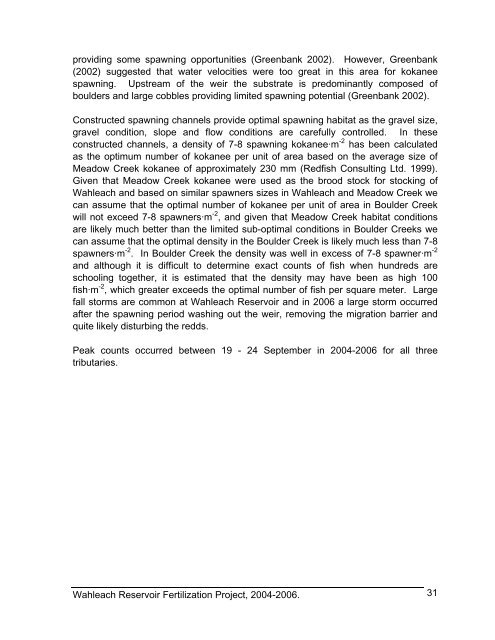Wahleach Project Water Use Plan Wahleach Reservoir ... - BC Hydro
Wahleach Project Water Use Plan Wahleach Reservoir ... - BC Hydro
Wahleach Project Water Use Plan Wahleach Reservoir ... - BC Hydro
You also want an ePaper? Increase the reach of your titles
YUMPU automatically turns print PDFs into web optimized ePapers that Google loves.
providing some spawning opportunities (Greenbank 2002). However, Greenbank<br />
(2002) suggested that water velocities were too great in this area for kokanee<br />
spawning. Upstream of the weir the substrate is predominantly composed of<br />
boulders and large cobbles providing limited spawning potential (Greenbank 2002).<br />
Constructed spawning channels provide optimal spawning habitat as the gravel size,<br />
gravel condition, slope and flow conditions are carefully controlled. In these<br />
constructed channels, a density of 7-8 spawning kokanee·m -2 has been calculated<br />
as the optimum number of kokanee per unit of area based on the average size of<br />
Meadow Creek kokanee of approximately 230 mm (Redfish Consulting Ltd. 1999).<br />
Given that Meadow Creek kokanee were used as the brood stock for stocking of<br />
<strong>Wahleach</strong> and based on similar spawners sizes in <strong>Wahleach</strong> and Meadow Creek we<br />
can assume that the optimal number of kokanee per unit of area in Boulder Creek<br />
will not exceed 7-8 spawners·m -2 , and given that Meadow Creek habitat conditions<br />
are likely much better than the limited sub-optimal conditions in Boulder Creeks we<br />
can assume that the optimal density in the Boulder Creek is likely much less than 7-8<br />
spawners·m -2 . In Boulder Creek the density was well in excess of 7-8 spawner·m -2<br />
and although it is difficult to determine exact counts of fish when hundreds are<br />
schooling together, it is estimated that the density may have been as high 100<br />
fish·m -2 , which greater exceeds the optimal number of fish per square meter. Large<br />
fall storms are common at <strong>Wahleach</strong> <strong>Reservoir</strong> and in 2006 a large storm occurred<br />
after the spawning period washing out the weir, removing the migration barrier and<br />
quite likely disturbing the redds.<br />
Peak counts occurred between 19 - 24 September in 2004-2006 for all three<br />
tributaries.<br />
<strong>Wahleach</strong> <strong>Reservoir</strong> Fertilization <strong>Project</strong>, 2004-2006.<br />
31
















